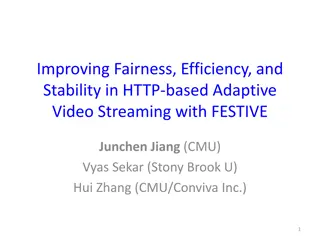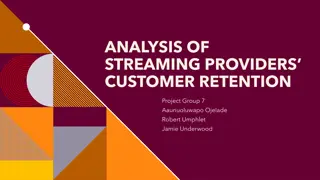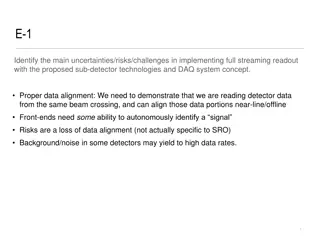Optimizing Top-K Monitoring in Streaming Data
Top-K monitoring involves tracking the best k values in a data stream for various applications such as bidding systems, financial analysis, and network security. Challenges include data storage, re-computations, and communication overhead. An optimal strategy for monitoring top-k queries in streaming windows is essential for efficient data processing. Predicted top-k values for consecutive windows and updates illustrate the dynamics of maintaining top-k values over time.
Download Presentation

Please find below an Image/Link to download the presentation.
The content on the website is provided AS IS for your information and personal use only. It may not be sold, licensed, or shared on other websites without obtaining consent from the author. Download presentation by click this link. If you encounter any issues during the download, it is possible that the publisher has removed the file from their server.
E N D
Presentation Transcript
Top-K Monitoring CS240B - Fall 2018 Professor Carlo Zaniolo Rishab Doshi (305220397) Nandan Parikh (605226525)
Outline Introduction Challenges Monitoring Top-K in Streaming Windows Distributed Top-K Monitoring Generalization of Distributed Query Processing Distributed Set expression cardinality
Introduction and Applications Top-K monitoring refers to keeping track of best k values in a data stream. Wide variety of applications require maintaining Top-K values as below: Bidding System Financial Analysis Most significant Transactions over a network DDoS Attack Analysis And so on...
Challenges Major challenge of handling expirations Data storage Number of re-computations Communication overhead by distributed query processing architecture Exchange of information: All updates shipped to central processing site is impractical - too much strain on network and central processor. Wireless sensor networks have a limited battery life and communication is more expensive than local computation.
An Optimal Strategy for Monitoring Top-k Queries in Streaming Windows Di Yang, Avani Shastri, Elke A. Rundensteiner and Matthew O. Ward Problem Statement Problem Statement Given a streaming dataset S S and preference function F F, a continuous top-k query Q(S S, win, slide, F F, k) returns the top-k objects within each query window Wi on the stream Query Window - Time or count based Remove expired objects from Wi-1and include new objects from S S
Predicted top-k for consecutive windows 16 objects initially Slide size = 4 Objects Result = Top 3 Approach : Predicted results at time of W0 Keeping all elements for each prediction in memory
Properties of Predicted top-k 1. Overlap : Windows tend to overlap, predicted values will have inherited as well as new values For any object in Wibut not in Wi-1, F(oi) < F(oj) 2. Fixed Relative Positions Since F score is fixed, the relative positions never change If an object is in predicted for Wi then it will be predicted for Wj( j > 0 )
Integrated View Maintenance Have only one superTopK list Keep pointers of all windows it can be a part of Large number of window marks according to use case More computations for insertion and expiration
Optimal Integration Strategy Keep track of start and end mark Keep lower bound pointer for each predicted window Easier List maintenance Reduces space and helps in handling expiration/insertion
Update process from time W0to W1 Update windows for top K elements, remove tuple where start > end Remove one object from each window for an object inserted above the window To handle each new object O(log(MinTopK.size)) Average Memory 2k elements
Distributed Top-K Monitoring Brian Babcock and Chris Olston Data streaming query and analysis has been a growing topic with lots of upcoming applications in networks, web-applications and financial systems. Lot of these applications require monitoring of top-k values across distributed systems. Shipping these to a central location and processing them continually is not practical. Authors have come up with an algorithm to provide top-k answer within user- specified error tolerance with minimum communication costs. Arithmetic constraints have been maintained at remote stream sources ensuring validity of top-k answers to within a user-specified error tolerance. Distributed communication is only necessary on occasions when constraints are violated.
Real World Scenario Monitoring Query 1 : Which web documents are currently the most popular, across all servers? Monitoring Query 2 : Within the local cluster of web servers at each of the four geographical locations, which server in the cluster has the lowest current load?
Architecture Architecture Monitor Nodes : Ni( m nodes) Coordinator Node : No Objects : O ( Total n ) Values corresponding to each : V Partial Values : V(object ,node)
Formal Model N0maintains an approximate top-k set T T valid within an error ? For each node Njdefine partial data values Vi,jfor every Object Oi The total value for an object is the sum across all nodes Vi,j= ( Oi, Nj, ) t Adjustment Factors are defined so that top-k at each node are maintained i,j(object i and node j) where j i,j= 0 At all nodes the sum of adjustment factor and partial value for top-k should be greater than the other objects
Example Consider two monitor nodes N1 and N2 Two objects O1 and O2 Partial values at : N1are V1,1= 9 and V2,1= 1 N2are V1,2 = 1 and V2,2= 3 We can choose : 1,1= -3 and 2,1= 0 1,2= 3 and 2,2 = 0
Algorithm Steps Phase 1 : The node at which one or more constraint fails, sends a message to the coordinator with the failed constraints and its border value ( Resolution ) Phase 2 : The coordinator determines whether all invalidations can be ruled out based on information from nodes Nfand N0alone. If so, re-establish constraints for nodes N0and Nf Phase 3: The coordinator requests relevant partial data values from all other nodes and then computes a new top-k. Reallocation is called then.
Calculation of border values Calculated whenever an arithmetical constraint has been violated at node It is minimum of (least value in Top-k and max value not in Top-k). As name suggests, it is at the border of being in the Top-k values in the set
Reallocation Phase Called when one of arithmetic constraints has been invalidated. If reallocation phase is called in phase 2 of resolution, only co-ordinator node N0 and violated node Nfare involved in resolution If reallocation phase is called in phase 3 of resolution, this implies that top-k set T has changed, in this case all nodes N0...NMare involved. This computes the new adjustment factors for all the objects in the resolution set. This is done by first making sure all violated constraints are fixed and all invariants are tight. Total leeway lifor each object Oiis then distributed across all nodes based on fraction Fj for node j. The values for Fj and li can affect the frequency with which reallocation is called again and hence values must be chosen carefully.
Generalization of Top-k monitoring So far, we have considered top-k elements in a single and a distributed streaming system. To generalize, top-k is essentially a query applied to a distributed system. Can these concepts be generalized/extended to other queries in a distributed system? YES! We discuss one example: Set expressions on Distributed Datasets
Problem Statement If a set is being continually updated by distributed streams of data at different remote locations, how do we efficiently perform queries like cardinality of set, union, intersection of the set?
Queries on Distributed Sets Challenges Challenges Suffers from similar challenges as discussed previously. Key observation Key observation Often, we don t need exact answer to the query in a distributed data stream environment.
Use-case: Detecting DDOS Consider detecting distributed denial-of-service (DDoS) attacks by analyzing network flow information collected from an ISP s border routers. 100s of compromised zombie hosts flood a specific victim destination with large numbers of seemingly legitimate packets. IP address spoofed to escape identification Sudden spike in number of unique IP source addresses can be used to detect distributed denial of service attacks. (cardinality of set of IP source addresses) Difference cardinality query |S T | to detect significant traffic deviations S is the IP source address set for the sliding window spanning the past week (until now) and T is the set of IP source addresses from the week prior to that (e.g., two weeks ago) Don t need exact count, just want to be able to detect spike or sudden change. Don t need exact count, just want to be able to detect spike or sudden change.
Proposed System m + 1 sites and n update streams 0 is a special coordinator site responsible for generating answers to user (set- expression cardinality) queries
At each remote site j, the n update streams render n distinct multi-sets S0,j, . . . , Sn1,jof elements from the integer domain [M] = {0,...,M 1}. Each stream up-date at remote site j is a triple of the form < i,e, v >, i identifies the multi-set Si,j being updated, e [M ] is the specific data element whose frequency changes v is the net change in the frequency of e in Si,j, i.e., +v ( v ) denotes v insertions (resp., deletions) of e. Deletion in the model helps in handling window queries. For each i=0,...,n 1, let Si= jSi,j. Thus, Sireflects the global state of the i th update stream, while each multi-set Si,jcaptures the local state of stream i at site j.
Formalizing Requirement Answering set-expression cardinality queries over the underlying collection of distributed update streams. Given a set expression E over streams S0, . . . , Sn 1(with the standard set operators , , and as connectives), estimate cardinality |E|, the number of distinct elements in E. Example, |S0 S1| is the number of distinct elements in the intersection of streams S0and S1. Where S0and S1are distributed across remote sites. Since approximate answers suffice - Compute: such that, X = |E| X - < < X + . is allowable error value - large value implies fewer communication costs
Values maintained Site j: curr_Si,j - most recent state of substream Si,j last_Si,j- last value of Si,jsent to co-ordinator(co-ordinators view of Si) For each stream Si, co-ordinator constructs last_Siby Union(last_Si,j) and computes cardinality by |last_Si| error tolerance curr_Si,j last_Si,j j Fi Other values discussed ahead j is error budget allocated to site j Ci(e) of the number of remote sites whose states Si,j contain the element e. Co-ordinator: last_Si,j Fi Threshold T Elements whose counts Ci(e) exceed a threshold T are considered to be frequent, and added to a frequent element set F Fi ifor stream Si .
Procedure to estimate Single Stream Cardinality Consider estimating cardinality of a single maximum permissible error: . single stream Sidistributed across j sites with Distribute error tolerance among m remote sites, proportional to stream updates at each site. j is error budget allocated to site j Ex: If sites 1, 2, 3 exist & 2 has highest update rate, then 2 gets largest error tolerance 2. Compute charge for every tuple(discussed ahead) and update curr_Si,j Communicate to co-ordinator when total charge exceeds error budget j. On communication, co-ordinator updates last_Si,jand communicates changes to frequent elements Fi and threshold values to other sites.
Charge System Every remote site computes a charge value associated with every update. Total_positive_charge(tpc) - sum of all new additions at the site Total_negative_charge(tnc) - sum of all deletions at the site Whenever the absolute value of total charge(+/-) value exceeds error budget at that site, it communicates to the coordinator with the latest state of the site. Send curr_Si,j to co-ordinator if tpc > jor tnc < - j Charge updation: Charge=1 is added to tpc if a new element is inserted. i.e., it doesn t exist in last_Si,j but is present in curr_Si,j Charge=1 is subtracted from tpc if an element is removed from curr_Si,j, i.e., it doesn t exist in curr_Si,j but is present in last_Si,j
Treatment of Frequent Elements Frequent elements appearing in the stream updates can be exploited to reduce charge. Ex: In an IP network monitoring scenario, popular sites like Google, Facebook will appear many times in the destination IP address. Even if frequent elements are added or deleted from one particular site, it is unlikely to have modified the global picture => we should not charge 1 every time a change occurs to a frequent element. Instead we charge a fraction 1/ i(e) where i(e) is the min. number of sites for which e appears in last_Si,j. i(e) is calculated by co-ordinator for all frequent elements Fi after every central update. The values of i(e) and Fi are synchronous between co-ordinator and remote sites
Results Set Expression Query. Distinct Values Query. Queries: Dataset description: Packet trace containing two hour s worth of all wide-area TCP traffic between the Lawrence Berkeley Laboratory and the rest of the world. Sets: S0, S1 and S2. Exp1:(S0 S1) S2 Exp2: (S0 S1) S2
References 1. Di Yang, Avani Shastri, Elke A. Rundensteiner, and Matthew O. Ward. 2011. An optimal strategy for monitoring top-k queries in streaming windows. In Proceedings of the 14th International Conference on Extending Database Technology (EDBT/ICDT '11), Anastasia Ailamaki, Sihem Amer-Yahia, Jignesh Pate, Tore Risch, Pierre Senellart, and Julia Stoyanovich (Eds.). ACM, New York, NY, USA, 57-68. DOI=http://dx.doi.org/10.1145/1951365.1951375 Brian Babcock and Chris Olston. 2003. Distributed top-k monitoring. In Proceedings of the 2003 ACM SIGMOD international conference on Management of data (SIGMOD '03). ACM, New York, NY, USA, 28-39. DOI: https://doi.org/10.1145/872757.872764 Abhinandan Das, Sumit Ganguly, Minos Garofalakis, and Rajeev Rastogi. 2004. Distributed set-expression cardinality estimation. In Proceedings of the Thirtieth international conference on Very large data bases - Volume 30 (VLDB '04), Mario A. Nascimento, M. Tamer zsu, Donald Kossmann, Ren e J. Miller, Jos A. Blakeley, and K. Bernhard Schiefer (Eds.), Vol. 30. VLDB Endowment 312-323. 2. 3.























